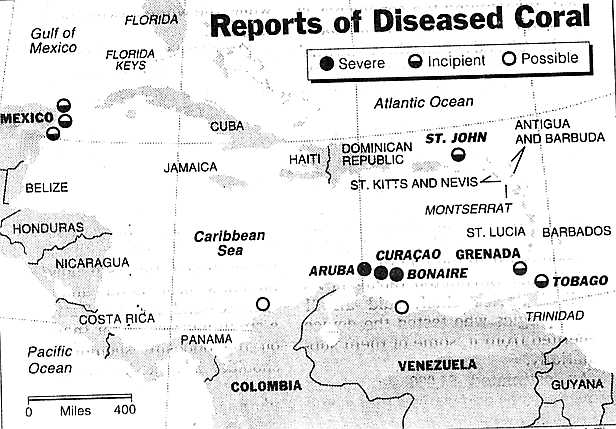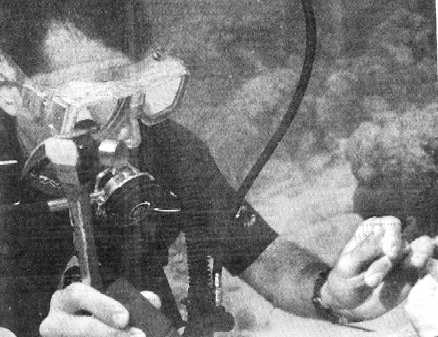Mysterious New Diseases Devastate Coral Reefs
New York Times Science Desk | 8/19/1997
Carol Kaesuk Yoon (NYT)
ABSTRACT – Researchers say many mysterious new diseases are attacking coral reefs around the world, and that corals, some centuries old, are quickly succumbing; rash of new diseases takes researchers by surprise; fewer than dozen of new diseases even have names, and simply recognizing whether coral is healthy or sick can be extremely difficult, even for practiced researchers; scientists say multiple stresses, like bleaching, sedimentation and pollution, may have pushed corals to point where they cannot fend off diseases they have fought off in past; others suggest that dumping of sewage into sea has brought host of new pathogens in contact with corals; fact that basic information about diseases is unknown fills researchers with dread about future of corals around world.
Two coral researchers were asked to examine the reefs off the island of Bonaire in January after divers noticed strange white lesions on the star and brain corals in waters considered to be among the most pristine in the Caribbean.
Underwater, the researchers, Dr. Thomas J. Goreau and James Cervino, found something they had never seen before, huge patches of dead coral, bright white where the skeleton had been exposed after tissue had died; the skeleton itself was crumbling away.
“We were quite horrified,” said Dr. Goreau, who along with Mr. Cervino is with the Global Coral Reef Alliance, a nonprofit organization for the protection and management of reefs. “It looks like someone poured acid over the top of the coral. The skeleton itself is dissolved. I’ve been looking at reefs in the Caribbean probably longer than anyone else alive and I’d never seen it before. It’s attacking at a speed and with a level of damage that is unprecedented”
The researchers say rapid wasting disease, so named because it can spread several inches across a coral head in a single day, is all over the reefs of Bonaire and since January has been spotted in Mexico, Aruba, Curacao, Trinidad, Tobago, Grenada and St. John’s in the Virgin Islands, an area spanning 2,000 miles.
But more alarming than the spread of rapid wasting disease is the fact that it is only one among many mysterious new diseases that have been discovered attacking corals around the world. In what they are describing as an epidemic, researchers say that in the last few years corals, some centuries old, from the Florida Keys through the Caribbean to places as distant as the Philippines, are quickly succumbing to diseases never before seen.
Unlike the many other stresses on corals with which scientists and the public have become quite familiar, including bleaching, sedimentation, pollution and rising sea temperatures, the rash of new diseases has taken researchers by surprise.
“We’re all stunned at the rapidity with which these new diseases are occurring,” Said Dr. James W. Porter, a marine ecologist who last year discovered a new disease known as white pox. “The problems are occurring at all depths, and the number of species affected is increasing as well as the number of individuals. It’s definitely on the rise.”
Dr. Drew Harvell, an ecologist at Cornell University in Ithaca, N.Y., whose graduate student in the Philippines, Laurie Raymundo, recently found a disease in all her study areas that they have been unable to identify, said: “There seem to be more diseases than anyone can keep up with. There are a lot of new names and attempts to correlate symptoms with names and with causes, but so far, heaven only knows what’s going on.”
Fewer than a dozen of the new diseases even have names and those with names are still in the process of being documented, leaving biologists to rely on word of mouth to keep the growing number of maladies straight. As a result, simply recognizing whether a coral is healthy or sick can be extremely difficult even for practiced researchers.
Last month at a meeting of the Association of Marine Laboratories of the Caribbean held in San Jose, Costa Rica, Dr. Goreau spoke at a special daylong session devoted to coral diseases, one of the first chances researchers have had to exchange information on the problem.
“I showed about 50 pictures” of coral diseases.” Said Dr. Goreau, “Most people said, ‘We’re seeing all of these diseases, but we just didn’t know it.’”
For example, rapid wasting disease, which exposes a white, crumbling skeleton, is easily and often mistaken for anchor damage or parrotfish bites.
Scientists say they have no idea why diseases are exploding on corals now. Some speculate that multiple stresses like bleaching, sedimentation and pollution, have pushed corals to the breaking point so that they are now unable to fend off diseases that they have fought off in the past. With the scant and scattered information, there seems to be little sense to their spread, with some pristine reefs succumbing to disease while other much more polluted reefs remain healthy.
“It’s a baffling situation.” Dr. Goreau said. “Most diseases are new.
They don’t correlate with each other or any known environmental stress. In Bonaire, rapid wasting disease is having a devastating impact, yet the reefs there are so clean.”
Others have suggested that perhaps erosion and the dumping of sewage and other wastes into the sea has brought a whole host of new pathogens in contact with corals and some of which are taking hold. While the notion that terrestrial pathogens might begin underwater attacks on corals might seem far fetched, researchers say there is evidence that at least one of the newly emerging diseases, sea fan disease, is caused by an organism that invaded from land.
Discovered just four years ago, this disease of soft corals is now widespread in the Caribbean and has been shown to be caused by a highly opportunistic fungus called Aspergillum. Adhering to sediment that has washed into the sea, the fungi begin to grow when they encounter a sea fan. Researchers say they are sure it is a fungus brought from land because it cannot complete its life cycle in the ocean. “It’s a terrestrial organism that has crossed the land-sea barrier,” Dr. Harvell said.
Researchers suspect a fungus is behind rapid wasting disease and various bacteria are implicated in other new coral diseases. But for the most part, definite causes remain unknown.
Scientists say even corals in aquariums, like the Waikiki Aquarium in Honolulu and the National Aquarium in Baltimore, are being hit.
In order to make identification of disease more straightforward, some researchers are trying to develop molecular tests for coral diseases. Dr. Harvell and colleagues are working on a test for sea fan disease trying to develop a sort of DNA fingerprint of the pathogen that would allow researchers who suspect that coral has the disease to test DNA from the infected area and find out definitively if the fungus that causes sea fan diseases is present.
As scientists struggle to identify illnesses, cures for sick corals appear to be a long way off. Some have suggested simply applying antibiotics to the reefs. Scientists warn however, of the unknown hazards of dispensing into the seas a drug that can destroy useful bacteria as easily as harmful bacteria and that may not do any good if the pathogens that are involved turn out not to be bacteria at all.
Researchers have had the most luck treating black band disease by vacuuming off the diseased band of tissue that gives the illness its name. But the work is extremely time-consuming and this type of approach is practically impossible for the most quickly spreading and worrisome disease.
I couldn’t imagine going out and treating a disease like that,” said Dr. Laurie Richardson, an aquatic microbiologist at Florida International University of Miami who studies white plague type 2, a disease that swept throughout the upper Florida keys in 1995. In just four months, it spread more than 100 miles, jumping from one to 17 species of corals.
But while scientists lament having to stand back and watch these diseases ravage coral populations, they note that sometimes no treatment can be the best cure. Once a disease is allowed to rage through an area, any healthy, resistant individuals left behind can begin to rebuild a tough population.
Other inhabitants of reefs are beginning to come down with diseases as well. Dr. Goreau said sponges, coralline algae and sea urchins were also succumbing to new illnesses, further threatening the health of reef communities.
Coral reef biologists say they are further frustrated by a lack of money for such quickly unfolding research.
“We’ve tried getting money from the National Science Foundation,” said Dr. Goreau. “You send a proposal and wait a year or two for the review. You can’t deal with this kind of science emergency that way.”
Researchers are now scrambling to document the extent of these emerging diseases, the numbers and types of corals attacked, and the level of virulence of these pathogens. But with such basic information still largely unknown, they are left with a mixture of dread and hope.
Dr. Cervino, for one, is soliciting reports of new outbreaks of coral diseases from observers around the world.
“There are places where there are 200- and 300-year-old coral colonies being devastated,” said Dr. Esther Peters, senior scientist at Tetra Tech, an environmental consulting company in Fairfax, Va., “and there are places where the corals are fine. I’m afraid it is getting worse, but all is not lost yet.”

